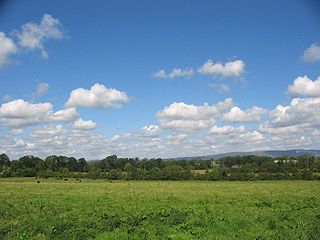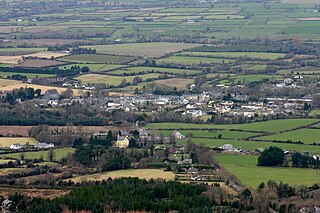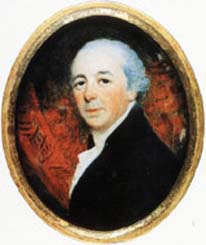
Mitchelstown is a town in County Cork, Ireland with a population of approximately 3740. Mitchelstown is situated in the valley to the south of the Galtee Mountains, 12 km south-west of the Mitchelstown Caves, 28 km from Cahir, 50 km from Cork, 59 km from Limerick and 10 km from Fermoy. The River Gradoge runs by the town into the River Funshion, which in turn is a tributary of the River Blackwater. The town is best known as a centre for cheese production.

Cahir is a town in County Tipperary in Ireland. It is also a civil parish in the barony of Iffa and Offa West.

Ballyporeen is a village in County Tipperary, Ireland. The national census of 2016 recorded the population of Ballyporeen at 318 with an additional 603 in its rural hinterland.

Ardfinnan is a small village in County Tipperary in Ireland. It is situated on the River Suir and R665 regional road. The Catholic parish of Ardfinnan is made up of three areas: Ardfinnan, Ballybacon, and Grange. Ardfinnan is also a civil parish in the ancient barony of Iffa and Offa West. The village is located 14 kilometers from the town of Clonmel and six miles from Cahir via the R670 road. The population of the village is approximately 1000 people.

Galtymore or Galteemore at 918 metres (3,012 ft), is the 12th–highest peak in Ireland on the Arderin scale, and the 14th–highest peak in Ireland according to the Vandeleur-Lynam scale. Galtymore has the 4th highest topographic prominence in Ireland which classifies Galtymore as a P600, or "major mountain". Galtymore is also one of the 13 recognised Scottish Furths, or Irish Munros, in Ireland. Galtymore is the County Top for both Limerick and Tipperary, and it is the highest mountain of the Galty Mountains, or Galtee Mountains, a 30–kilometre range that runs east–west, split between Limerick and Tipperary in Munster, Ireland.

The Golden Vale is an area of rolling pastureland in the civil province of Munster, southwestern Ireland. Covering parts of three counties, Limerick, Tipperary and Cork, it is the best land in Ireland for dairy farming. Historically it has been called the Golden Vein. An early instance is an 1837 book by Jonathan Binns, a British government official, where he refers to the area as '"the golden vale" ' and states "The land is of excellent quality, being part of the golden vein of Ireland—a district reaching from Tipperary towards Limerick. The extent of the golden vein is about fourteen miles long, by six or seven wide." Some subsequent writers similarly prefer "vein".

Clogheen is a village in County Tipperary, Ireland. The census of 2006 recorded the population at 509 people.

Anglesboro or Anglesborough is a small village at the foot of the Galtee Mountains, in southeastern County Limerick, Ireland. The nearest town is Mitchelstown in County Cork approximately 12 kilometres away.

The R639 road is one of Ireland's regional roads. Once designated the N8 national primary road, it was reclassified in stages as the R639 following the progressive opening of sections of the M8 motorway, which rendered the single carriageway N8 redundant as a national primary road. By-passed sections of the old N8 were generally reclassified as R639 as soon a new section of M8 opened, thereby increasing the length of the R639. With the completion of the M8 on 28 May 2010, the R639 now stretches from Durrow, County Laois to Cork, running through counties Laois, Kilkenny, Tipperary, Limerick and Cork.
The Glen of Aherlow is a valley located between Slievenamuck and the Galtee Mountains in the western part of County Tipperary in Ireland. The principal village is Lisvarrinane. There is also a hamlet at Rossadrehid, where Aherlow creamery was located before its closure in the late 20th century. Other adjacent centres of population are the villages of Galbally, Kilross and Bansha. Across the northern flank of Slievenamuck lies Tipperary Town.

Tubrid or Tubbrid was formerly a civil and ecclesiastical parish situated between the towns of Cahir and Clogheen in County Tipperary, Ireland. A cluster of architectural remains at the old settlement still known as Tubrid includes an ancient cemetery and two ruined churches of regional historical significance.

Kilbehenny is a village in County Limerick, Ireland, on the R639 regional road. It is situated on the County Cork border and is within two kilometers of the County Tipperary border. The village is 5 km (3.1 mi) east of Mitchelstown, the nearest town, and 1 km from Junction 12 of the M8 Dublin to Cork motorway.

The M8 motorway is an inter-urban motorway in Ireland, which forms part of the motorway from the capital Dublin to Cork city. The 149 km motorway commences in the townland of Aghaboe, County Laois and runs through the counties of Kilkenny, Tipperary and Limerick, terminating at the Dunkettle interchange in County Cork. First called for in the Road Needs Study (1998), it was later incorporated into the National Development Plan (2000–2006) and later still formed part of the Irish Government's Transport 21 plan for infrastructural development. The majority of the M8 (115 km) was built between 2006 and 2010. On 28 May 2010, the motorway was completed and had replaced almost all of the single-carriageway N8 except for a short section of urban road in Cork City.

Glengarra Wood is a mixed woodland in Ireland located 15 kilometres (9.3 mi) southwest of Cahir, Co. Tipperary off the M8 motorway and R639 road. Approximately 570 hectares in extent, it is situated on Old Red Sandstone on the southern slopes of the Galtee Mountains. It is mainly a coniferous forest with Sitka Spruce being the main species. Other conifer species present include Scots Pine, Japanese Larch, Douglas Fir, Norway Spruce, Western Hemlock and Western Red Cedar. The area also contains approximately 50 hectares of native Oak, Birch and Alder. Animals present include fallow deer, foxes, badgers, hares and red squirrels. Birds include pheasants, hawks, kestrels, ravens, herons and many song birds.

Skeheenarinky is a townland in south-west County Tipperary, Ireland. It is a dispersed settlement with a focal point at Skeheenarinky Cross where a school is located.
Mitchelstown Cave is a limestone cave near Burncourt, County Tipperary, Ireland. Situated 12 kilometres (7.5 mi) from Mitchelstown, County Cork, it became the first cave in Ireland to be developed for the public in 1972.

Galtee Castle was a mansion that was situated on the foothills of the Galtee Mountains at Skeheenarinky in County Tipperary, Ireland approximately 10 km. from Mitchelstown.

The River Funshion is a river in Munster, Ireland, a tributary of the Munster Blackwater.

Burncourt Castle is a fortified house and a National Monument in County Tipperary, Ireland.

























